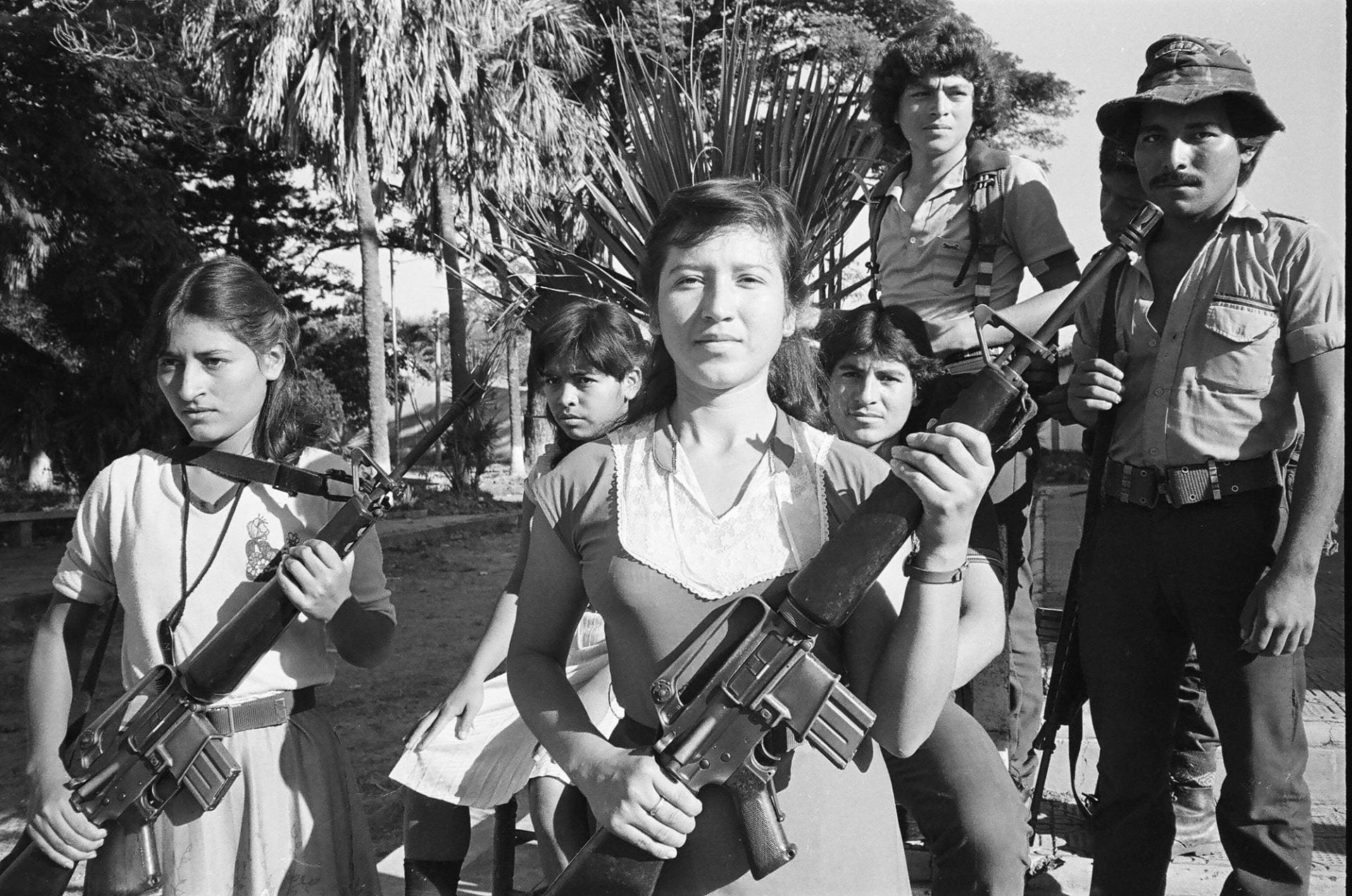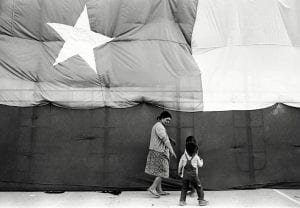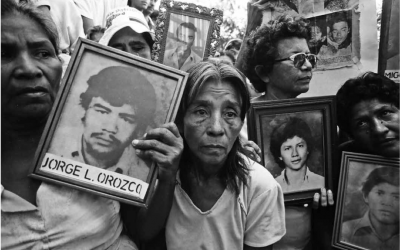The Rub
Against the Proud Grain of Chile’s History
Brace yourself as you enter the Museum of Memory and Human Rights in Santiago de Chile. Galleries of missing people will glare back at your glance, from a wall so enormous the collective calamity exceeds the span of your vision. The photographed faces float over funerary candles in the above ground altar, and another subterranean crypt designed by Alfredo Jaar shows an eerie nothing at first. Then the slow illumination lights up a repeated emptiness outlined by rows and rows of head-shot silhouettes. Throughout the main building video viewing rooms run endless loops of testimonies by victims, including women who report the insertion of rats into their vaginas after routine rapes. Hallways host more videos of footage from the long period of repression: footage, for example, of public beatings in broad daylight, and also of admirable protests. There are maps that document the despotism, poignantly personal artifacts that once belonged to eliminated persons, statistics that confirm the enormity of officially sanctioned crimes against Chileans.
The museum substantiates the horror of Pinochet’s assault on citizens, in case anyone is in doubt. It commemorates their lost lives, lost to the ultimate blow of death but also lost in trickles, by dispirited survivors. Citizens who lived through those years are haunted by the horror of a national army that ravaged compatriots. This was no civil war of brother against equal brother, ugly and desperate though that kind of conflict can be, but a one-way, top-down, scourge of civilians by brute military power.
The bunker-like museum building is a monument to the recent past, erected during Michelle Bachelet’s presidency. Her legacy here is a relentless reminder that the wages of authoritarianism far exceeded the alleged establishment of order and decency after Chile freely elected a socialist president. Pinochet’s crusade against communism and anything else that came in his way cost Chile even more than the vibrant lives of social reformers along with those of unsuspecting neighbors. His crack-down crushed the collective confidence and hopes that came with a particularly Chilean sense of political pride and dignity.
Chile, you see, has a distinguished political history which surely framed the violent 1973 Coup as a shock, an unbelievable aberration. By the 1830s, while other Latin American countries were busy fighting civil wars, the popular and factional struggles that followed independence movements throughout the continent had been contained through O’Higgins’ government. What’s more, the successful democratizing experiments launched by Liberals (beginning in the 1820s) gave Chile the enviable reputation as the only stable democracy in all of Latin America (and most of Europe). In 1852 Juan Bautista Alberdi spoke for all the Argentine refugees from Rosas’ government when he proposed a toast to this haven from anarchy, “the honourable exception in South America.” (Simon Collier, “Chile from Independence to the War of the Pacific,” The Cambridge History of Latin America: Vol III, From Independence to c. 1870 [Cambridge: Cambridge University Press, 1985] pp. 583-614).
Already a worldwide banking center in the 1850s, Chile had built the first major railroad in South America, and was exploiting coal and copper mines for domestic industries as well as for export. Chile continued to constrain the disintegration of an elite consensus, making the country an enduring model of stability and productivity. With the founding of The University of Chile in 1842, under the leadership of Andrés Bello (that master of conciliation), the state established a training center for a modern citizenry (see Iván Jaksic’s Academic Rebels in Chile: The Role of Philosophy in Higher Education and Politics [Albany: SUNY Press, 1989], especially pp. 21-34).
There were, to be sure, armed conflicts between Liberals and Conservatives while civil wars raged throughout the hemisphere. In 1851 and again in 1859 Liberals and Conservatives were literally at each others’ throats. But the traditionalist bankers and the freethinking miners learned to make up quickly, before broad-based rebellions challenged the legislative systems that Bello helped to put in place. A Liberal-Conservative conciliation and the consequent political continuity came to seem inevitable. The country achieved distinction as a “democracy of the oligarchy.” (John Crow, The Epic of Latin America 3rd ed. expanded and updated. [Berkeley, University of California Press, 1980] The quote is his title for chapter 48 of this once popular text, about Chile in the second half of the 19th century: pp. 640-648).
After a century and a half of dependable democracy—however limited the access to power and whatever the in-equalities in the distribution of resources—Chileans must have been astonished at the sudden loss of liberties and legality. They were bereft of familiar paradigms. Repression of this blunt and brutal variety was the experience of other countries, countries such as the Argentina remembered in Alberdi’s toast. Political exiles from elsewhere had historically fled to the safe and neutral sanctuary that Chile represented.
The Museum of Memory makes no mention of the country’s admirable heritage. It has nothing to remind visitors of the positive reasons to take pride in the country as a collective political patrimony, one that could help to rebuild a common sense (in Kant’s meaning of shared subjectivity). The museum misses a cue for inclusion, I fear. Many Chileans apparently choose not to visit the museum, alleging its one-sidedness about history. That can hardly be helped in an institution designed precisely to uncover the shameful events and dynamics of a dictatorship that had conveniently hidden or misconstrued the facts of repression. But the laser focus on shame—without framing the longer view—has the unfortunate effect of cutting out the public’s cause for pride, the reason why Chile’s citizens might be invited to care so intimately about democracy.
During my May 2013 visit to the museum, I walked in along with a local father and his 8 or 9-year-old son. The unhappy child heard his father explain that he may well be in a group photo of a crowd being broken up by armed forces, urging the boy to help locate the image. But their visit lasted only a few minutes, probably ending just after we entered the loop of obscenely detailed testimonies about sexual abuse. I wondered then how long they might have lasted in the museum if there were also galleries of Chilean glory to visit, along with the horror, even if the stamina for pain and fear remained finite. Could an expanded Museum of Memory include a long view to urge citizens to remember national accomplishments alongside national shame? The combined effect might even heighten the horror, given the political dimensions of the loss along with all the rest. But a side effect might be a welcoming embrace of inclusion. The pleasure and pride in this particular patriotism wouldn’t have to distinguish between sides of a conflict. It would share a heritage worthy of the struggle against forgetfulness.
Doris Sommer teaches Latin American Literature at Harvard. She is author of several books including Foundation Fictions: The National Romances of Latin America, Bilingual Aesthetics, and The Work of Art in the World: Civic Agency and Public Humanities (forthcoming). Sommer directs the Cultural Agency Initiative to develop arts and humanities as social resources.
Related Articles
A Search for Justice
In 2004, when I left Harvard and last saw you, I thought I would never learn the truth of what exactly happened to Carlos Horacio in the horrendous holocaust of the Palace of Justice in Bogotá. Yet fate was holding a tremendous surprise for my daughters and me, filled with…
Memory: Editor’s Letter
Editor's Letter Memory Irma Flaquer’s image as a 22-year-old Guatemalan reporter stares from the pages of a 1960 Time magazine, her eyes blackened by a government mob that didn’t like her feisty stance. She never gave up, fighting with her pen against the long...
A Search for Justice in El Salvador: One Legacy of Ignacio Martín-Baró
In the small rural town of Arcatao, Chalatenango, Rosa Rivera clung to the hope that one day she would find the remains of her disappeared mother and father and lay them to rest in peace. Others sought to exhume mass graves hoping to recover bodies of nearly 1,000 relatives massacred in the Río Sumpul. …





